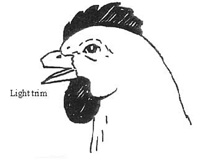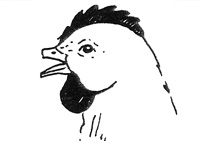



Cannibalism by Poultry
By Sheila E. Scheideler, Extension Poultry Specialist and Sara Shields, Research Technologist. This NebGuide summarizes the causes, control and prevention of cannibalistic behavior displayed by poultry. Beak trimming as a method of prevention is also discussed.Cannibalistic behavior performed by poultry is the pecking, tearing and consuming of skin, tissues or organs of flock mates. Outbreaks of cannibalism occur in all types of housing systems, including cages, floor pens, aviaries; in outdoor, free-range flocks; and among many different types of poultry, including chickens, ducks, turkeys, quail and pheasants. Birds will show cannibalistic behavior when they are crowded or feed-restricted. Flock behavior and inter-bird dynamics often include aggression of birds toward each other, which can ultimately result in injury.
Cannibalism is a separate problem that may occur long after dominance relationships have been established. Cannibalism differs from dominance as it actually causes physical harm. Cannibalism may begin with feather pecking and is usually directed toward the body, toes, tail and especially the vent area. Prevention of cannibalism is much easier than treatment.
Causes of Cannibalism
Cannibalism is caused by a combination of genetic and environmental factors. Although the exact etiology is unknown, many management conditions and genetics can predispose a flock to an outbreak. Some of these are:
- Insufficient access to resources, including feed, water, perch or nesting space.
- Strain differences in propensity to feather peck and display cannibalism.
- Dietary absences or deficiencies (example: salt deficiency).
- Bright lighting.
- Injured birds left in the flock.
- Large group size.
- Keeping different ages or colors together.
- Injuries that bleed as a result of protruding cage or pen wires, enclosures in poor repair or from fighting among newly mixed birds.
- Diseased or birds with low body weight.
- Photostimulation programs designed to produce early onset of lay.
- Barren environments that restrict or limit behavior, especially normal nesting and foraging behavior.
- Changing the diet to a less-preferred food.
Prevention
Outbreaks can occur in the best-managed flock. However, problems are less likely to arise if preventative measures are in place. The first step in a cannibalism control program is to select a genetic stock that is not prone to cannibalism and then give the birds the best care possible, including adequate feed, carefully managed lighting, safe housing and environmental enrichment.
Providing a complete ration to meet the nutrient needs for age and type of flock is also very important. Cannibalism has been linked to deficiencies in protein, sodium and phosphorus. Protein requirements change as chicks grow and should be adjusted based on a recommended feeding schedule. Adequate feeder space for all birds to eat simultaneously helps prevent underweight birds that are frequently victims of cannibalism.
Older cages and enclosures should be replaced before injuries and pecking become common. Cannibalistic chickens, injured birds, victims of cannibalism and dead birds should be quickly removed from the flock.
Environmental enrichment is the practice of putting objects in the cage or pen to provide interest and a greater variety of behavioral outlets. For hens, environmental enrichments that reduce the incidence of cannibalism include nest boxes, perches, foraging opportunities and other things that might redirect pecking away from flock mates.
A dark nest box provides a safe place for egg laying and prevents exposure of the everted cloaca during oviposition to potentially cannibalistic flock mates. Because the cloaca is highly attractive for pecking, some outbreaks of cannibalism begin during oviposition. Hens can escape aggressive vent pecking by perching high enough off of the ground that they cannot be reached by hens on the floor. Pullets are more likely to use perches as a refuge if they are reared with them from an early age.
Pullets reared on a litter type that is attractive for scratching and pecking are less likely to develop cannibalistic behavior. A chicken’s natural behavior includes spending a considerable portion of the day searching for food. When the environment is not suitable for the expression of normal foraging behavior, pecking can sometimes be redirected toward flock mates and this may lead to cannibalism. It is important to provide foraging opportunities such as straw, green leafy vegetables or grass clippings, or to feed small grains in deep litter. A mash diet, rather than pelleted feed, may also help prevent outbreaks of cannibalism because chickens sift through the variety of ground particles and take longer to consume their feed.
Enrichment devices made of string have also been shown to redirect pecking. Four to eight lengths of white polypropylene twine hung in the cage or pen should elicit pecking and may help prevent aggressive pecking toward flock mates. Enrichment devices that are moved or changed periodically are more effective in keeping the birds’ attention. Ideally, poultry should be allowed protected outdoor access where they can display the full range of their natural foraging and exploratory behaviors.
A combination of careful selection of genetic stock and good management practices prevents most cannibalism; however, beak trimming is often practiced as a preventative method. The practice of beak trimming is associated with both acute and chronic pain and should not be practiced indiscriminately. Neuromas, tangles of severed nerve endings in the amputated beak stump, sometimes result from beak trimming.
Until alternatives to beak trimming are developed, the potential painfulness of this practice should be weighed against the likelihood of a cannibalism outbreak when making the decision to beak trim. Current research aimed at preventing cannibalism through genetic selection of more docile stock may prevent the need to beak trim in the future.
Control of a Cannibalism Outbreak
Although it is better to prevent cannibalism, if an outbreak does occur, it is essential to stop the behavior quickly before it spreads throughout the flock. A variety of methods are available to help accomplish this objective, although it is difficult to stop a substantial outbreak altogether. Some corrective steps include:
- Separate birds doing the severe feather pecking, especially if directed at the injuries or vents of other birds.
- Remove victims of cannibalism and care for them separately or euthanize them humanely, if necessary.
- Dim lights to a lower intensity of between 5 and 10 lux (about 5- to 10-foot candles).
- Add enrichments, especially foraging-related devices.
- Add additional feed and water space.
- Add nest boxes and perches.
- Use an antibiotic wound spray on the everted cloaca of hens with vent trauma (in small flock situations).
- Consider therapeutic beak trimming.
Beak Trimming
 Figure 1. Acceptable Figure 1. Acceptable |
 Figure 2. Too severe Figure 2. Too severe |
 Figure 3. An example of a beak trimmer. Figure 3. An example of a beak trimmer. |
The avian beak is highly innervated and, like the human hand, is very sensitive to touch, temperature and pressure. Chickens use their beaks not only for gathering food but also for exploring and manipulating objects in the environment, preening, dustbathing, nesting and social interactions. Beak trimming is not only painful, it deprives the bird of important sensory information. However, if alternatives have been exhausted, a careful beak trimming program will prevent most cannibalism outbreaks.
Cannibalism does not spread as efficiently in caged systems for laying hens, given sufficient access to feed and water space and low numbers of birds per cage. Medium hybrid laying hen stock should not need beak trimming when housed in battery cage systems. However, White Leghorn light hybrids housed at high cage stocking densities (less than 70 square inches per hen) can experience very high mortality from cannibalism. Although stocking densities greater than 86 in2/hen are not recommended, crowding above this level without extensive measures to prevent cannibalism necessitates beak trimming.
If the decision is to beak trim, the procedure should be done between seven and 10 days of age and only by properly trained personnel. Beak trimming errors can result in additional pain and suffering to an already stressful procedure or may fail to prevent cannibalism.
It is important to remove the correct amount of beak. Severe beak trims result in neuroma formation and the build up of scar tissue; but a conservative trim of only one-fourth to one-third of the upper beak (measured from the tip to the nostril) and slightly less of the lower beak usually prevents this outcome. The beak should be trimmed at an angle from top to bottom to remove less of the lower mandible (Figures 1 and 2). An example of a beak trimmer is pictured in Figure 3.
A heated blade is usually used to trim beaks. However, new technologies using lasers and infrared beams are currently being researched, and producers should be prepared to adopt these new methods if they become available. Bleeding will occur if the blade on a hot blade trimmer is too hot or too cold or if environmental temperatures cause the flock to become overheated. For more information on training, contact one of the UNL poultry extension specialists.
Pre- and Post-trimming Management Tips
Steps can be taken to minimize stress, bleeding, weight loss and dehydration both before and after beak trimming. Some procedures that will help:
- Keep the birds as cool as possible if trimming during hot weather. It is better to do the work early in the morning or after sundown. Keep fresh, cool water available at all times.
- Extra vitamin K should be added to the water (5 mg/gallon or 20 mg/liter) two days prior to trimming and two to three days following beak trimming.
- Vitamin C (20 mg/liter or 80 mg/gallon) can also be added to the water at the same times.
- For the first four to seven days after trimming, increase feed depth to a minimum of 2 inches. Chicks are not capable of pecking the bottom of the feeder at this time.
- Stimulate feed consumption by adding feed twice daily or running mechanical feeders more often. Feed a prestarter, starter or high-density stress feed for one week following beak trimming.
- Lower water pressure or trigger cup watering devices manually for several days following beak trimming. It is difficult for newly trimmed chicks to operate automatic waterers immediately following trimming.
- Birds should not be subjected to stress from housing, vaccinating or worming (outdoor birds) during the week prior to or two weeks following trimming.
- Check birds often to monitor healing following beak trimming.
- If significant beak re-growth occurs, a second beak trim may be necessary. This should be done at or prior to eight weeks of age.









